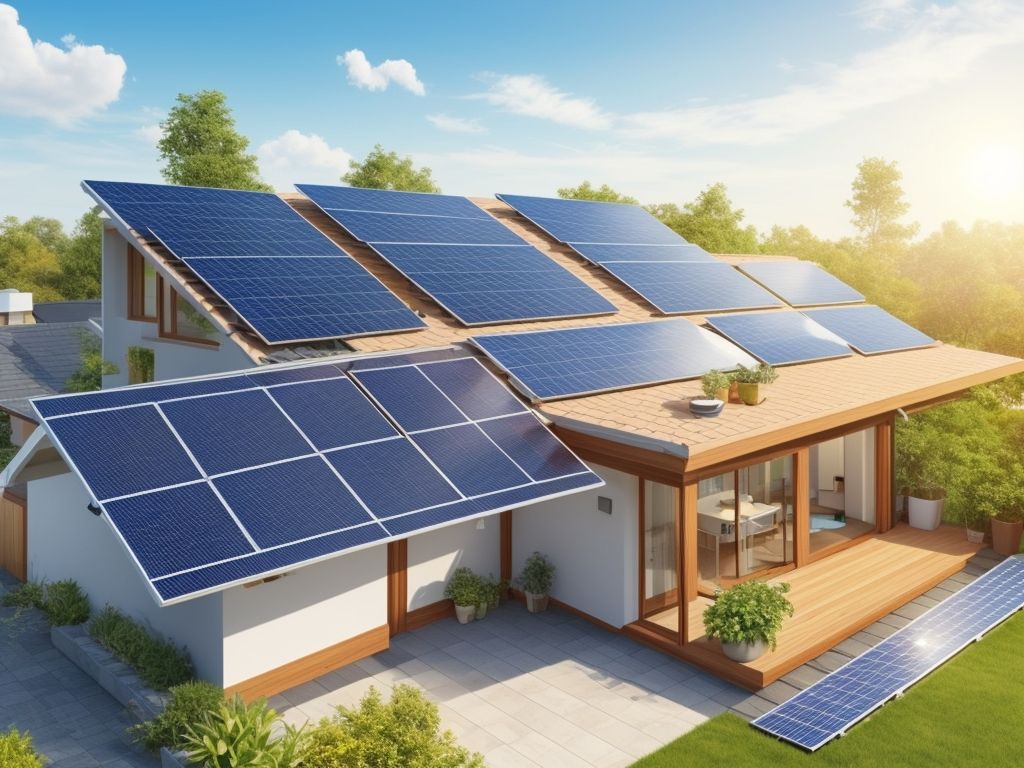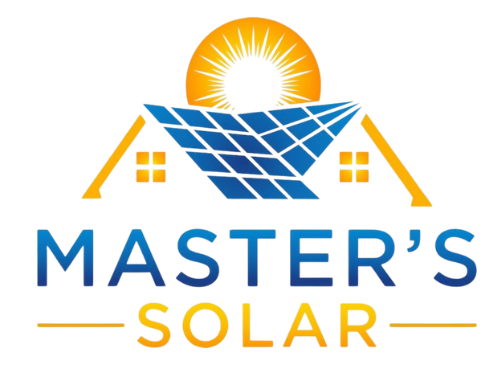Solar panels are a trendy choice for taking advantage of the sun’s energy and creating clean, renewable energy in the home. These cutting-edge devices turn sunlight into electricity, reducing reliance on fossil fuels and decreasing carbon emissions. With their smooth design and eco-friendly advantages, solar panels have become a desirable option for homeowners hoping to save money while contributing to a greener future.
Using the sun’s energy starts with photovoltaic (PV) cells within solar panels. When light from the sun hits these cells, it activates the electrons inside, causing them to flow and create an electric current. This direct current (DC) is then changed into alternating current (AC) via an inverter, making it suitable for household appliances and electrical systems.
Setting up solar panels requires careful consideration of various factors, like roof orientation, shading, and available space. Additionally, figuring out your energy needs and calculating system size can help optimize performance and guarantee maximum savings. While initial costs might seem intimidating, incentives like federal tax credits and net metering programs can make going solar more economical than ever.
A unique part of solar panels is their capability to work even on cloudy days. While direct sunlight produces ideal results, PV cells can still generate electricity from diffused or indirect sunlight. This means that even if you live in an area with fewer sunny days or experience periodic overcast weather conditions, your solar panels will still create electricity.
According to the U.S. Department of Energy’s National Renewable Energy Laboratory (NREL), homes with solar panels usually generate 40-100% of their electricity usage from this renewable source. With improvements in technology and decreasing installation costs, it is no surprise that more homeowners are embracing solar power as a sustainable solution for their energy needs.
As we get started on a journey toward a more sustainable future, understanding how solar panels work at home is essential. By taking advantage of the sun’s energy through photovoltaic cells and converting it into usable electricity, solar panels offer an environmentally friendly and cost-effective way to fulfill our energy requirements. So why not join the millions of homeowners already benefiting from this clean energy solution?
What are solar panels?
Solar panels, often referred to as photovoltaic panels, are devices that capture the sun’s energy and turn it into electricity. They’re made up of tiny solar cells crafted from semiconductor materials such as silicon. These cells absorb photons from the sun, producing an electric current.
The way solar panels work is truly amazing. The photons strike the cells, setting off electrons from their atoms, creating a flow of electricity. This is known as the photovoltaic effect. This generated electricity can be used to power many appliances and devices in your home.
An interesting detail about solar panels is that they continue to generate electricity even when the sun isn’t visible. Direct sunlight produces the most energy, but panels still operate with lower efficiency in indirect or diffused light. So, even on cloudy days, solar panels can still provide a significant amount of power.
Pro Tip: For the best output from your solar panel system, make sure to keep them clean and free of dirt or debris. Routine upkeep will significantly boost their performance and extend their life.
How do solar panels work?
Solar panels revolutionize electricity generation. They harness the power of sunlight and convert it into usable energy.
The process starts with photovoltaic cells. These cells have semiconductors like silicon, which turn sunlight into direct current (DC) electricity. Photons strike the cells and loosen electrons, creating a current.
These panels are positioned to get as much sunlight as possible. They’re usually on rooftops or in open areas without shade. Solar trackers can also be used to move panels and make sure they always face the sun.
DC electricity goes through an inverter to become alternating current (AC). It’s fed into the home’s electrical system and ready for use.
Solar panels history goes back more than 150 years. In 1839, Becquerel discovered the photovoltaic effect during an experiment. This breakthrough laid the foundation for solar technology and our understanding of how panels work.
Solar panels are making a sustainable future for generations to come. They use the sun’s energy to power homes. Technology advances and accessibility are helping this clean energy solution.
Components of a solar panel system
Solar panel systems use several parts to capture the power of the sun and turn it into electricity. Let’s explore each one in detail.
The main component are the solar panels. They are made up of photovoltaic cells which take in sunlight and turn it into direct current (DC) electricity. The number of panels depends on the energy needs.
Next is an inverter. It changes the DC electricity from the solar panels to alternating current (AC) electricity used in homes.
An optional part is a battery storage system. It stores excess electricity from peak sunlight hours for when there is not much sunlight or during power outages. It gives more independence from the grid and uses solar energy better.
A charge controller regulates current between the solar panels and batteries. It prevents overcharging or voltage damage.
Finally, an electrical meter and utility grid connection. This measures incoming energy from the grid and outgoing energy from the solar panel system. Any extra electricity can be sent back to the grid or sold to the electric company.
Remember: Regular maintenance and cleaning will increase efficiency and the lifespan of the solar panel system. Remove dirt, debris, or snow from the panels for best performance.
By learning about each part of the solar panel system, people can make smart decisions about switching to clean energy. Solar energy reduces reliance on fossil fuels and helps make a healthier environment.
Installation of solar panels
Installing solar panels at home can be easy and provide many benefits! This guide will help make the installation successful.
- Assess your property. Look at the layout and orientation of your home. Identify areas with no shade, plenty of sunlight, and no obstructions.
- Consult a pro. Get advice from an experienced solar panel installation company or professional. They’ll suggest the size, type, and number of solar panels you need.
- Installation and connection. Securely mount the solar panels on your roof. Connect them to an inverter that turns DC power into usable AC power.
Connect the inverter, electrical panel, and utility grid too. Government incentives and financial savings make solar panels a cost-effective investment.
Pro Tip: Clean your solar panels regularly for the best performance. This will remove any dirt or debris that could block the sun.
Connecting the solar panel system to your home
- Assess your energy needs: Evaluate daily electricity consumption to figure out the size and capacity of the solar panel system needed.
- Install the inverter: Place the inverter near the main electrical panel. It changes DC to AC, powering appliances.
- Connect to the grid: Link the solar panel system to the grid. Earn credits for extra electricity sent back to the grid. Draw from the grid when there isn’t enough sunlight.
Professional installation is recommended. Maintenance is important; clean the panels from dust or debris for optimum sunlight absorption.
Stat: 46% of new electricity generation in 2020 was from solar installations. Solar is becoming a popular alternative energy source.
Benefits and considerations of solar panels at home
Solar panels have plenty of advantages. They’re sustainable and renewable, cutting down electricity bills and helping the environment. Plus, they boost the value of your home and provide backup power in outages. Little maintenance is needed and they last for years.
Before you install solar panels, it’s important to take into account details like sunlight access, roof direction, local laws, and initial costs. Getting advice from pros guarantees best use of solar energy.
Fun fact: In 2020, the USA installed over 19GW of solar capacity, according to the Solar Energy Industries Association (SEIA)!
Conclusion
Solar panels are an amazing technology that has changed the way we use electricity. They convert sunlight into energy for our homes. Here, we have seen how solar panels work and their advantages for homeowners. Let’s summarise what we’ve learnt.
We’ve seen that solar panels can reduce our need for other energy sources and help the environment. They use photovoltaic cells to capture sunlight and turn it into direct current (DC) electricity. An inverter then changes this DC electricity into alternating current (AC) electricity, which can power our appliances.
Net metering is another thing to consider. With net metering, you can send extra energy produced by your solar panels back to the grid. You get credits on your electric bill, or even money, for the extra energy you make. This decreases the cost of getting solar panels and encourages people to use renewable energy.
Let’s look at Sarah, a homeowner who installed solar panels. At first, she was doubtful, but soon realised their potential. Her energy bills went down and her carbon footprint decreased. She became an advocate for solar energy and encouraged others to switch too.
Frequently Asked Questions
1. How do solar panels work at home?
Solar panels work by converting sunlight into usable electricity. They are made up of photovoltaic (PV) cells that absorb sunlight and generate a direct current (DC) electricity. An inverter then converts this DC electricity into alternating current (AC) that can be used to power your home.
2. What are the benefits of solar panels at home?
Installing solar panels at home provides several benefits. Firstly, it reduces or eliminates your electricity bill as you generate your own renewable energy. Solar panels also help reduce carbon emissions and dependence on fossil fuels. Additionally, some regions offer incentives and tax credits for switching to solar energy.
3. How much space do I need for solar panels at home?
The amount of space required for solar panels depends on factors such as the size of your energy consumption and the efficiency of the panels. On average, a 1 kilowatt (kW) solar panel system requires about 80-100 square feet of space. However, solar panels can be installed on rooftops, in backyards, or even on walls, so space availability should not be a significant concern.
4. Can solar panels generate electricity during cloudy days?
Yes, solar panels can still generate electricity on cloudy days. While direct sunlight produces the most electricity, solar panels can still produce a significant amount of power from diffuse sunlight. However, the efficiency may be reduced, and the amount of electricity generated will vary depending on the cloud cover.
5. Do solar panels require regular maintenance?
Solar panels are relatively low maintenance. They have no moving parts, so there is minimal wear and tear. However, it is recommended to have them inspected every few years to ensure optimal performance. Additionally, keeping the panels clean from dust or debris can improve their efficiency.
6. Can solar panels work during a power outage?
Typically, solar panels alone cannot power your home during a power outage. This is to prevent an electrical backflow to the power lines, which can pose a safety risk for utility workers. However, with a battery storage system, excess solar energy can be stored and used during blackouts, providing a backup power source.
Related posts:
- How Much Does Solar Increase Home Value? | Zillow Insights
- How Much Do Home Solar Panels Cost? A Complete Guide to Solar Panel Prices
- Determining the Perfect Size: How Much kW Solar Panel is Required for Your Home
- How Many Solar Panels to Power Home? A Comprehensive Guide on Calculating Solar Panel Requirements



